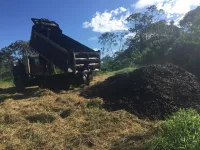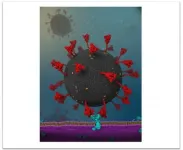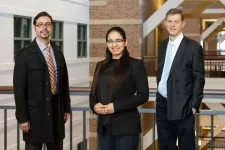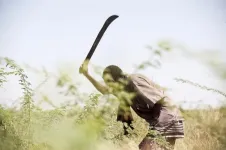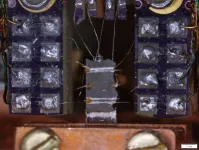(Press-News.org) A new study finds that coffee pulp, a waste product of coffee production, can be used to speed up tropical forest recovery on post agricultural land. The findings are published in the British Ecological Society journal Ecological Solutions and Evidence.
In the study, researchers from ETH-Zurich and the University of Hawai`i spread 30 dump truck loads of coffee pulp on a 35 × 40m area of degraded land in Costa Rica and marked out a similar sized area without coffee pulp as a control.
"The results were dramatic" said Dr Rebecca Cole, lead author of the study. "The area treated with a thick layer of coffee pulp turned into a small forest in only two years while the control plot remained dominated by non-native pasture grasses."
After only two years the coffee pulp treated area had 80% canopy cover compared to 20% in the control area. The canopy in the coffee pulp area was also four times taller than that of the control area.
The addition of the half metre thick layer of coffee pulp eliminated the invasive pasture grasses which dominated the land. These grasses are often a barrier to forest succession and their removal allowed native, pioneer tree species, that arrived as seeds through wind and animal dispersal, to recolonise the area quickly.
The researchers also found that after two years, nutrients including carbon, nitrogen and phosphorous were significantly elevated in the coffee pulp treated area compared to the control. This is a promising finding given former tropical agricultural land is often highly degraded and poor soil quality can delay forest succession for decades.
Dr Cole said: "This case study suggests that agricultural by-products can be used to speed up forest recovery on degraded tropical lands. In situations where processing these by-products incurs a cost to agricultural industries, using them for restoration to meet global reforestation objectives can represent a 'win-win' scenario."
As a widely available waste product that's high in nutrients, coffee pulp can be a cost-effective forest restoration strategy. Such strategies will be important if we are to achieve ambitious global objectives to restore large areas of forest, such as those agreed in the 2015 Paris Accords.
The study was conducted in Coto Brus county in southern Costa Rica on a former coffee farm that is being restored to forest for conservation. In the 1950's the region underwent rapid deforestation and land conversion to coffee agriculture and pasture with forest cover reduced to 25% by 2014.
In 2018, the researchers set out two areas of roughly 35 × 40m, spreading coffee pulp into a half meter-thick layer on one area and leaving the other as a control.
The researchers analysed soil samples for nutrients immediately prior to the application of the coffee pulp and again two years later. They also recorded the species present, the size of woody stems, percentage of forest ground cover and used drones to record canopy cover.
Dr Cole warns that as a case study with two years of data, further research is needed to test the use of coffee pulp to aid forest restoration. "This study was done at only one large site so more testing is needed to see if this strategy works across a broader range of conditions. The measurements we share are only from the first two years. Longer-term monitoring would show how the coffee pulp affected soil and vegetation over time. Additional testing can also assess whether there are any undesirable effects from the coffee pulp application."
A limitation of using coffee pulp or other agricultural by-products is that its use is mostly limited to relatively flat and accessible areas where the material can be delivered and the risk of the added nutrients being washed into nearby watersheds can be managed.
On further research into the use of coffee pulp, Dr Cole said: "We would like to scale up the study by testing this method across a variety of degraded sites in the landscape. Also, this concept could be tested with other types of agricultural non-market products like orange husks.
"We hope our study is a jumping off point for other researchers and industries to take a look at how they might make their production more efficient by creating links to the global restoration movement."
- Ends -
INFORMATION:
Twenty percent of high school students have easy access to a handgun, according to a new study from the Colorado School of Public Health on the University of Colorado Anschutz Medical Campus.
In the study published today in The Journal of Pediatrics, the researchers examined the prevalence of handgun access among adolescents in Colorado and explored individual and geographic characteristics, as well as related health factors.
"Our findings highlight that it is relatively easy to access a handgun in Colorado for high school students. This finding, combined with ...
Growing cities tend to run out of land for waste management and new landfill sites.
Artificial Intelligence can help city managers create more powerful long-term forecasts of solid waste volumes and landfill requirements, even with missing or inaccurate data.
UJ researchers found that a 10-neuron model produced the best 30-year forecast for municipal solid waste in a growing city.
All over the world, large cities are running out of space for municipal solid waste. Existing landfill sites are rapidly filling up and no-one wants a new site anywhere near their homes or businesses. Meanwhile, taxpayers aren't interested in higher costs for quality waste management either.
One way of significantly extending ...
Groundbreaking research from the University of South Australia has delivered world-first national-level guidelines to better inform children's physical activity and screen time in Outside School Hours Care (OSHC).
Developed with input from the OSHC sector, the guidelines aim to address growing concerns of children's sedentary behaviour marked by an increase in regular screen time. Research shows that 31-79 per cent of OSHC sessions are sedentary.
The guidelines specifically encourage energetic play while discouraging screen use:
Before School Care should schedule 45 minutes of physical activities and no more ...
Arctic habitats have fascinated biologists for centuries. Their species-poor insect faunas, however, provide little reward for entomologists - scientists who study insects - to justify spending several weeks or even months in the hostile environments of tundra or polar deserts. As a result, data on insects from the High Arctic islands are often based on occasional collecting and remain scarce.
Vize Island, located in the northern part of the Kara Sea, is one of the least studied islands of the Russian High Arctic in terms of its biota. Scientists Dr Maria V. Gavrilo of the Arctic ...
WATERLOO, Ontario, March 29, 2021--A newly-published paper represents one of the most comprehensive reviews of advancements to come in contact lenses, catapulting the commonly-used medical device to applications well beyond refractive error correction.
Contact Lens Technologies of the Future (Jones L, et al.) is now in press from Contact Lens and Anterior Eye, the peer review journal of the British Contact Lens Association (BCLA). It joins nine other papers being printed in next month's special edition as part of the BCLA-led Contact Lens Evidence-based Academic Reports (CLEAR) series.
"There are a range of ...
Bioengineering researchers at Lehigh University have identified a previously unknown interaction between receptors in human cells and the spike, or "S," protein of SARS-CoV-2, the virus that causes COVID-19. This new information could aid in the development of new strategies to block SARS-CoV-2 entry into human cells.
X. Frank Zhang and Wonpil Im knew from recent studies that the interaction between the SARS-CoV-2 spike protein and angiotensin-converting enzyme 2 (ACE2) receptors in human cells is stronger than the interaction between the structurally identical spike protein of SARS-CoV-1, the virus that caused the 2002-2004 SARS outbreak, and the same receptors.
"Our goal was to characterize SARS-CoV-2 ...
CHAMPAIGN, Ill. -- Monitoring the progression of multiple sclerosis-related gait issues can be challenging in adults over 50 years old, requiring a clinician to differentiate between problems related to MS and other age-related issues. To address this problem, researchers are integrating gait data and machine learning to advance the tools used to monitor and predict disease progression.
A new study of this approach led by University of Illinois Urbana Champaign graduate student Rachneet Kaur, kinesiology and community health professor Manuel Hernandez and industrial ...
United Methodist churches -- whether the congregation is white or not -- have higher attendance when located within white neighborhoods. But racial diversity within a church is associated with higher average attendance over time, according to a new study.
"This is a startling contrast to previous research that reported multiracial congregations are less stable," said lead author Kevin D. Dougherty, Ph.D., associate professor of sociology at Baylor University.
The study is published in the journal Social Forces.
Previous research has found that it is difficult for congregations to build and sustain racially diverse memberships, ...
A new study suggests that clearing the invasive woody weed Prosopis julifora and grassland restoration in Baringo County, Kenya, may have significant financial benefits for local stakeholders and contribute to climate change mitigation.
Climate change, land degradation, and invasive alien species (IAS) such as Prosopis julifora are major threats to people's livelihoods in arid and semi-arid areas with each of these having negative impacts on ecosystem services - including vegetation biomass, which is a prime resource for pastoralists and agro-pastoralists.
The team, comprising PhD students and established scientists from four countries and different ...
LOS ALAMOS, N.M., March 26, 2021--New research has demonstrated that a magnetic uranium compound can have strong thermoelectric properties, generating four times the transverse voltage from heat than the previous record in a cobalt-manganese-gallium compound. The result unlocks a new potential for the actinide elements at the bottom of the periodic table and point to a fresh direction in research on topological quantum materials.
"We found that the large spin-orbit coupling and strong electronic correlations in a system of uranium-cobalt-aluminum doped with ruthenium resulted in a colossal anomalous Nernst conductivity," said Filip Ronning, lead investigator on the paper published today in Science Advances. Ronning ...
